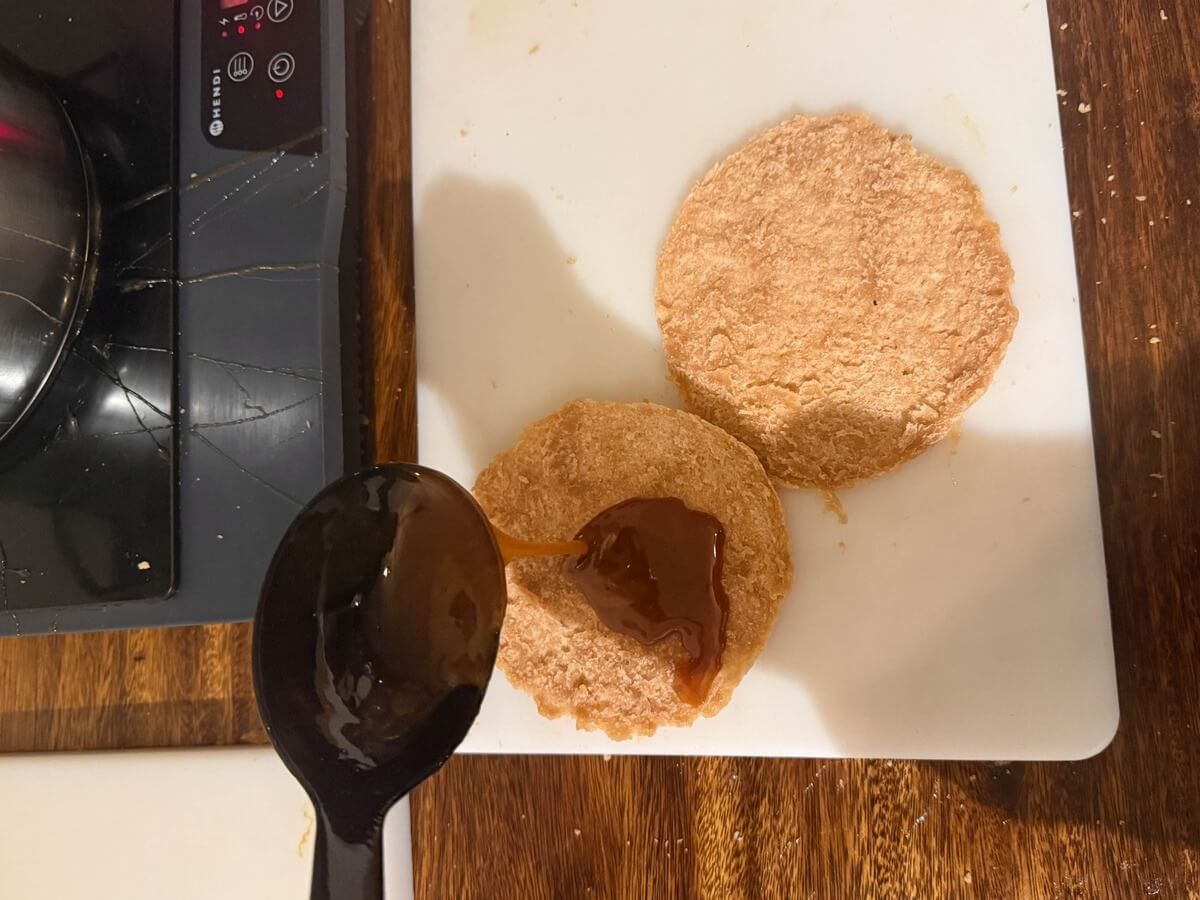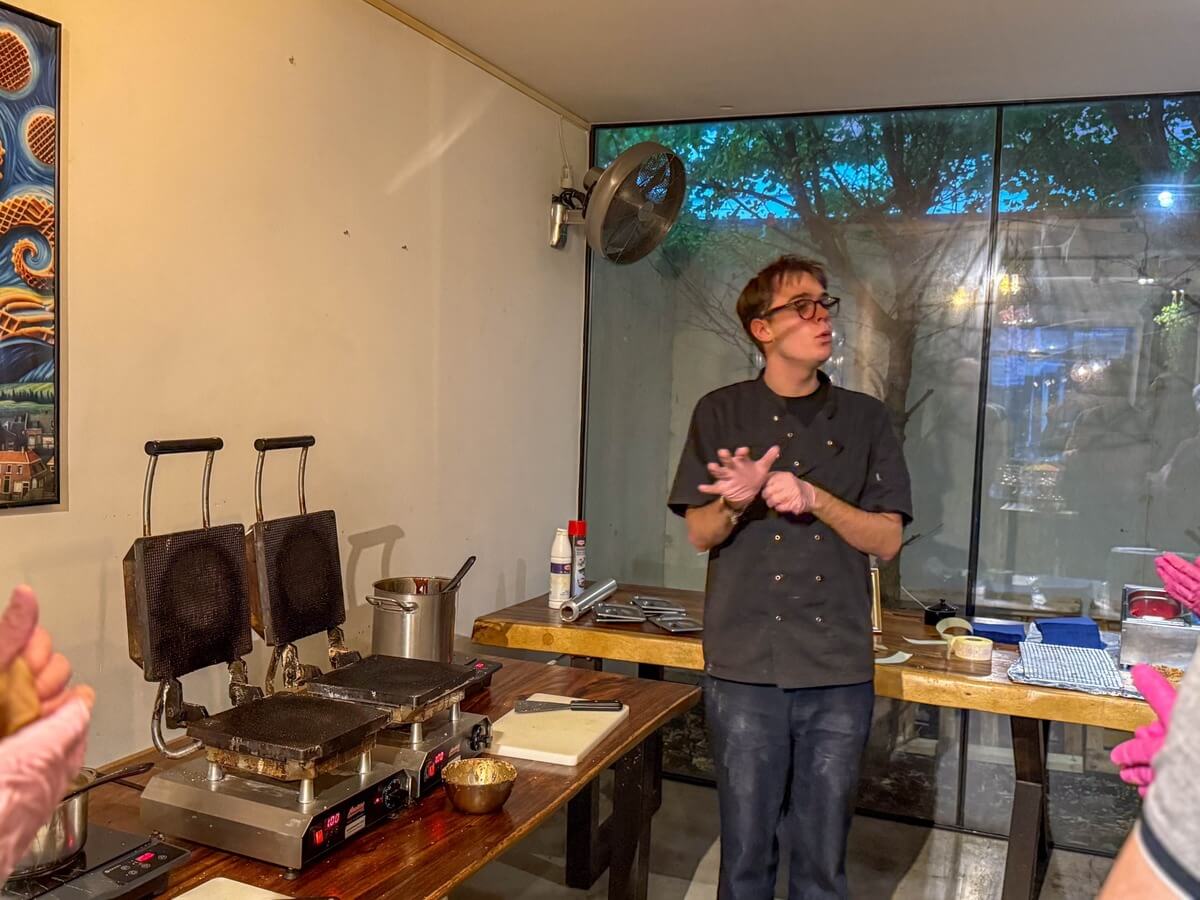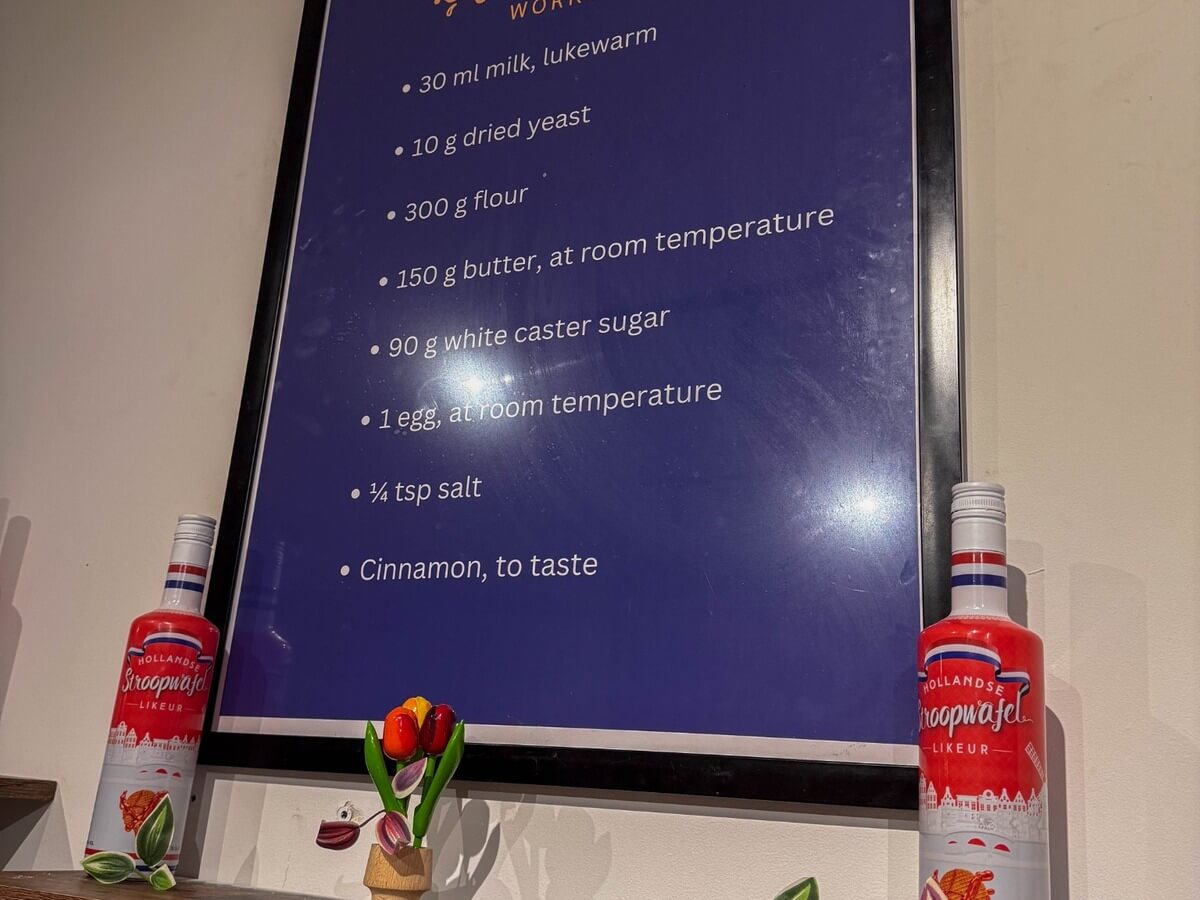
Stroopwafels – The Netherlands’ most famous cookie
If there’s one Dutch treat that manages to sneak into almost every suitcase leaving the country, it’s the stroopwafel. Two thin, round waffle cookies with a warm, spiced caramel syrup sandwiched in between: crispy on the outside, chewy in the middle, and dangerously addictive. Before diving in, here’s a quick stroopwafel 101. The stroopwafel comes from Gouda (yes, the cheese city), and its name literally means “syrup waffle” — “stroop” meaning syrup, “wafel” meaning waffle. Pronunciation? In Dutch it’s “strohp-vah-fel”, though you’ll hear everything from “stroop-waffle” to “strope-waffel” abroad. Internationally, you might see them described as syrup waffles, caramel waffle cookies or Dutch caramel wafers — all referring to the same iconic treat.

Stroopwafel dough ready to be pressed into the famous Dutch syrup waffles
How stroopwafels are made
At their core, stroopwafels are made of two simple parts: the waffle and the filling. The waffle is made from a stiff, yeasted dough using flour, butter, brown sugar, yeast, a splash of milk and an egg. The filling is a warm syrup mixture made from syrup, brown sugar, butter and cinnamon. Traditionally, the syrup wasn’t the silky caramel you find today, but something far more humble: sugar-beet molasses. Molasses was a by-product of sugar refining — thick, dark and not particularly glamorous on its own. But when bakers sweetened it, cooked it down and spiced it with cinnamon, it transformed into that irresistible stroop you find inside classic stroopwafels.
To make a stroopwafel, the dough is pressed in a hot waffle iron until thin and golden. While still warm, the waffle is sliced horizontally in half. The hot syrup is spread on one side, the top is placed back on, and as it cools, the filling thickens and glues everything together. Want to make stroopwafels at home? You’ll need a stroopwafel iron (or a very thin waffle/pizzelle iron) and basic baking ingredients: flour, butter, brown sugar, yeast, milk, eggs and cinnamon. For the filling, a mixture of golden syrup or light molasses, brown sugar, and butter gets you close to the original. It’s a bit of a project, but your home will smell like a Dutch market — which is always a win.

Stroopwafel workshop
If you want to become an ambassador of the “Stroopwafel”, you can now take a crash course in Amsterdam to become a real Stroopwafel artist in an hour. Join a true masterclass on making your own Stroopwafel, just the way you like it! There’s a Stroopwafel workshop, where you’ll learn exactly what it takes to make fresh Stroopwafel. It’s a fun activity for both young and old, and best of all, it includes some fresh, handmade Stroopwafels that you can completely customise to your own taste!

Take a stroopwafel crash course while in Amsterdam!
Stroopwafel recipe
If you want to attempt to make some homemade Stroopwafel, you shouldn’t have a hard time finding the right ingredients, as they are pretty basic and available anywhere in the world. Most likely, finding a waffle iron/toaster that allows you to press them thin enough will be a more difficult task, as well as Dutch “Stroop”.
These are the basic ingredients for the cookie dough of a traditional Stroopwafel:
- 30 ml milk, lukewarm
- 10 grams dried yeast
- 300 grams of flour
- 150 grams butter (at room temperature)
- 90 grams caster sugar (we personally prefer unrefined / brown)
- 1 egg at room temperature
- 4 grams of salt
- 3/4 tablespoon of ground cinnamon
The ingredients for the syrup between the waffles;
- 100 grams of brown sugar
- 175 grams of Dutch Stroop (make sure to take a bottle from the Netherlands if you plan on making them at home)
- 1 tablespoon of ground cinnamon
- pinch of salt

The recipe as taken from the Stroopwafel workshop

The history of the stroopwafel
Like many great foods, the stroopwafel began as a clever solution to food waste. In Gouda during the late 18th or early 19th century, bakers were left with crumbs, leftover dough, and trimmings from their daily baking. Meanwhile, local sugar refineries produced sugar-beet molasses as a cheap by-product. One thrifty baker decided to mix the leftovers with sweetened molasses, press the mixture between two thin waffles and sell it as an affordable cookie.
Early stroopwafels were so inexpensive that they were nicknamed “poor man’s cookies.” Over time, bakers refined the recipe, turning those humble scraps into the soft, chewy, caramel-filled waffle we know today. One name often credited is Gerard Kamphuisen, whose Gouda bakery (opened in 1810) is linked to one of the earliest written stroopwafel recipes.
What started as a local treat from a single Dutch city eventually spread across the country — and then the world.
Stroopwafels in Amsterdam
Walk around Amsterdam today, and you’ll see stroopwafels everywhere — in markets, cafés and souvenir shops. Among locals, the Dutch cookie has been popular for decades already. It is typically served as a treat with tea or coffee. However, in the past decade, popularity has been supercharged by the influence of social media platforms such as TikTok and Instagram. Smart entrepreneurs jumped on the bandwagon by opening speciality shops in Amsterdam that sell giant, freshly made versions decorated with chocolate dips, nuts, sprinkles, marshmallows, cookie crumbs, and gold dust — you name it. (considered heresy to traditional Dutch Stroopwafel enthusiasts) These oversized stroopwafels are beautiful, photogenic and… usually quite pricey. It’s not uncommon for tourists to pay over €10 for a single cookie.
The funny thing? Dutch people would rather dive into one of the Amsterdam Canals mid-winter than pay that price for a Stroopwafel. Supermarket stroopwafels are humble, inexpensive and closer to what locals actually eat. They may not come dipped in chocolate hearts or rainbow sprinkles, but in terms of flavour, they hold their own remarkably well. Still, the tourist popularity has reshaped the stroopwafel industry. What was once a modest market snack has evolved into a global “foodie moment,” complete with toppings that would shock any old-school Dutch baker. Tradition or trend — there’s room for both.

This is NOT what a traditional Dutch Stroopwafel is supposed to look like, but whatever floats your followers’ boats
Stroopwafels going international
The stroopwafel didn’t stay Dutch for long. Its fame travelled far beyond Gouda, and today it pops up in some surprising places. One of the biggest boosts to its international fame came from the skies: United Airlines introduced stroopwafels as its signature in-flight snack, and passengers loved them so much that the airline had to bring them back when it tried to remove them. Many Americans discovered their very first stroopwafel somewhere over the Atlantic rather than in the Netherlands itself.
Beyond the airline world, stroopwafels have found a home in supermarkets worldwide. In the US, Trader Joe’s sells them (including mini versions), Costco offers giant tubs imported from the Netherlands, and even Aldi has experimented with stroopwafel ice cream sandwiches. They’ve also appeared in hotel minibars, European cookie assortments and airport lounges. Coffee shops globally now embrace the classic “Dutch hack”: place a stroopwafel on top of your hot coffee and let the steam soften the caramel inside. Some cafés even launch stroopwafel-inspired drinks, like caramel waffle lattes.
In short: the stroopwafel has gone from a poor man’s cookie made from leftovers and sugar-beet molasses to an international icon that travels better than most snacks.

Photo credit Vincente Garzia
Final notes for enjoying stroopwafels
If you’re visiting Amsterdam, try at least one fresh, warm stroopwafel from a local market, or go and make one yourself during a stroopwafel workshop, but also pick up a pack from the supermarket to take home — your future self will thank you. Warm them gently over a hot drink to maximise the caramel melt. If you’re bringing them as a gift, the classic, undecorated version travels far better than the Instagrammable chocolate-covered ones.
From humble Gouda leftovers to global fame, the stroopwafel’s journey is a sweet one — and once you taste a good one, you’ll instantly understand why this caramel-filled Dutch cookie became the Netherlands’ most delicious ambassador.

0 Comments on "Stroopwafels – The Netherlands’ most famous cookie"
There are no comments on this post.